Introduction to Java Servlets (1) - PowerPoint PPT Presentation
Title:
Introduction to Java Servlets (1)
Description:
Java Servlets are server-side Java programs that handle client requests and generate dynamic web content. They run on a web server, extending its capabilities by processing incoming requests, managing sessions, and generating responses, typically in HTML. Servlets use the Java Servlet API and are a key component of Java EE for building scalable, robust web applications. They provide a powerful, efficient way to build interactive web pages and can interact with databases, perform business logic, and integrate with other web technologies. – PowerPoint PPT presentation
Number of Views:0
Title: Introduction to Java Servlets (1)
1
Introduction to Java Servlets
https//nareshit.com/courses/advanced-java-online-
training
2
Introduction to Java Servlets
Java Servlets are server-side Java programs that
handle client requests and generate dynamic web
content. They run on a web server, extending its
capabilities by processing incoming requests,
managing sessions, and generating responses,
typically in HTML. Servlets use the Java Servlet
API and are a key component of Java EE for
building scalable, robust web applications. They
provide a powerful, efficient way to build
interactive web pages and can interact with
databases, perform business logic, and integrate
with other web technologies.
3
What is Java Servlet?
A Java Servlet is a Java program that runs on a
server and handles requests from web clients,
typically browsers. Servlets are used to create
dynamic web content by interacting with web
clients via the HTTP protocol. Here's an
overview of their key features and
functions nareshit.com/courses/advanced-java-onl
ine-training
4
Lifecycle Management
Request Handling Servlets process incoming
requests, such as form submissions, by reading
data sent by clients.
Session Management
Response Generation They generate dynamic
responses, often in HTML, which are sent back
to the client's browser.
Servlets are managed by a servlet container
(e.g., Apache Tomcat), which handles their
lifecycle, including initialization, request
handling, and termination
They maintain session information across
multiple requests from the same client.
5
Platform Independence Servlets are written in
Java, making them platform-independent. They can
run on any server that supports the Java Servlet
API.
Scalability Servlets are well-suited for
building scalable applications. They can handle
large numbers of concurrent requests and can be
easily integrated with other Java EE components
like EJBs, JMS, and JDBC.
Performance Servlets are designed for
performance. They are loaded once and can handle
multiple requests, reducing the overhead
associated with process creation and resource
allocation.
Security Servlets support a range of security
features, including authentication,
authorization, and data encryption. They can be
configured to run in a secure environment and
use Java's robust security model.
Portability Since servlets follow the Java EE
standard, they can be deployed on any compliant
servlet container, such as Apache Tomcat, Jetty,
or JBoss.
Extensibility Servlets are highly extensible.
Developers can create complex web applications by
extending the basic functionality provided by
the Java Servlet API.
6
Thank You!
Contact Us Phone 91 8179191999 Mail support_at_nare
shit.com Website https//nareshit.com/courses/adv
anced-java-online-training Address 2nd Floor,
Durga Bhavani Plaza, Ameerpet, Hyderabad, 500016































